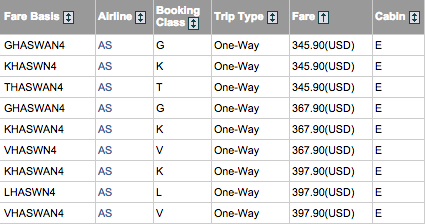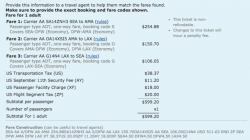It’s easier than you might think to improve your upgrade chances for a small additional cost. But you have to be paying attention. Book the wrong fare and you can see your chances greatly diminish.
That’s one reason I wrote my introductory series on ExpertFlyer.
- Introduction to ExpertFlyer: Fare Rules and Prices
- Introduction to ExpertFlyer: Finding Availability and Constructing Fares
- Introduction to ExpertFlyer: When Manual Fare Construction Helps or Hurts
- Introduction to ExpertFlyer: Combining Fares and Pricing Units
- Introduction to ExpertFlyer: Planning an Award Trip
The majority of ExpertFlyer’s features are not applicable to everyday travel needs. Instead I wrote those posts because I hope you’ll gain a better understanding of how airfare is priced, and that can lead to insights with practical applications elsewhere.

An example is my upcoming trip to Maui. I made a really foolish mistake when I booked my fare by not paying attention to the upgrade rules. Although my wife and I have a dozen MVP Gold Guest upgrades between us, I booked a very cheap G fare that is ineligible — along with R and T fares. I spent weeks of looking at that reservation, pretending that if I clicked on the “MVP Gold Guest Upgrade” button one more time something different would happen.
But it wasn’t until today, two weeks before the flight, that I stopped to consider what it would cost to change my ticket and buy an eligible fare.
Three dollars and ten cents.
Be Aware of Fare Restrictions When Using Upgrade Instruments
For just $3.10 my wife and I were able to change our tickets from an ineligible G fare to an eligible V fare and immediately redeem two upgrade certificates for confirmed first class seats. (There was no additional charge for her ticket since we had used a fixed-cost companion fare.)
The difference in price was so small because those MVP Gold Guest Upgrade instruments apply to a wide range of fares, and it’s not uncommon for fares on the low or high end to vary by a small amount. Usually it’s a little more than $3.10, but not much more. Here’s an example of an upcoming flight from San Diego to Maui. You can see that for $33 more than the cheapest fare I can apply an upgrade. Compare that to $330 more to buy an actual first class fare.
Keep in mind that there has to be upgrade space available when redeeming an upgrade. At least I can call dibs any time after I book instead of waiting until closer to departure for the computer to process upgrades automatically.
You Can Skip the Instrument by Paying More
Upgrade instruments tend to apply to a broad range of fares with few exceptions. United doesn’t impose limits if you’re flying domestic when using Regional or Global Premier Upgrades, and American doesn’t have restrictions on any of its flights when using eVIP Upgrades.
But if you don’t have any instruments — or if you ran out — many carriers still permit upgrades in advance when you buy more expensive fares. These can still save you some money vs. buying first class and work particularly well for last-minute fares when “expensive” is your only option.
Here’s an example of a slightly more expensive upgrade option for the same Alaska Airlines flight that doesn’t require an instrument as long as you have MVP Gold status. Now I’ll have to pay $163 more than the cheapest fare, but I’m still saving $167 compared to a first class ticket.
Book More Expensive Fares to Advance in the Queue
Okay, okay, there’s no upgrade space available, you don’t have any instruments, and you can’t afford paying an extra $100-200 for a pricey coach fare. You still have some options.
Complimentary elite upgrades processed closer to departure are often ranked based on elite status and fare class. How many other people bought the cheapest ticket available? You don’t have to buy the most expensive ticket, but if you can pay $10 more and jump ahead of them in line, isn’t that worth something? United Airlines does a particularly good job of letting you specify an exact fare class online so you can book what you want.

This trick also works when you’re redeeming an upgrade instrument and put on the waitlist because no upgrade award space was available when you requested it. Everyone trying to use a United Global Premier Upgrade books a W fare, the cheapest eligible fare but often $500 more than the cheapest ineligble fare — and that’s just for a chance at an upgrade. Consider that a V fare ranks higher and is sometimes just $10-50 more. Given the sunk cost, is it worth it to pay an extra 10% to stand out from the crowd?
Everyone is trying to save money. I get that. I think there’s some value to paying a little more than necessary to improve your odds.
Which Fares are Eligible for Upgrades at the Time of Booking?
Upgrade rules are nuanced, so I’ve linked to each program below for you to read the full details. This is my attempt at simplifying the information for easier comprehension. Remember, fares not listed here may still be eligible for complimentary upgrades closer to departure.
Upgrades Using Instruments
Note: Although upgrade instruments are typically awarded to those with elite status, they can be shared with friends and family who don’t have that status. They may or may not work on international flights.
Alaska Airlines: All fares except G, R, and T fares.
American Airlines: All fares.
Delta Air Lines: All fares except E fares.
United Airlines: All domestic fares. Upgrades on most international flights are not permitted on Z, P, S, T, K, L, N, and G fares.
Upgrades on Full-priced Fares
Note: You need to have a certain elite status to take advantage of these upgrades. These rules usually apply only to domestic flights and select international routes.
Alaska Airlines: MVP members can upgrade Y, S, and B fares. MVP Gold and MVP Gold 75K members can also upgrade M and H fares.
American Airlines: All elite members can upgrade Y and B fares.
Delta Air Lines: All elite members can upgrade Y fares.
United Airlines: Most elite members can upgrade Y and B fares. Premier 1K members can also upgrade M fares.
Watch Out for Change Fees
Because I have MVP Gold status with Alaska, all change fees are waived even on non-refundable fares. But it’s still a hassle, and lower status MVP members will have to pay up, as will members of many other loyalty programs. I strongly recommend you explore some of the options described above before you purchase a ticket.
If you forget, a few airlines will sometimes waive the change fee for customers who want to re-book the same flight in a higher booking class, i.e., “re-fare” the ticket. And if you’re not so lucky, you might find that the fare difference is small enough that you’re still willing to pay the change fee for a better shot at an upgrade on some longer routes.






